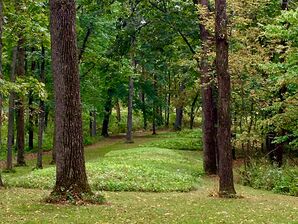Effigy Mounds National Monument
Established in 1949, Effigy Mounds National Monument preserves many American Indian ceremonial mounds found in the shape of animal effigies along the high bluffs and lowlands of the Upper Mississippi River Valley. The 2,526 acre Monument preserves more than 200 mounds, including 31 in the form of bear and bird effigies. The hunter-gatherer culture that built these mounds were known as the Woodland Indians. Archeologists and researchers hypothesize that some of the mounds were built for religious ceremonies, burial ceremonies, as clan symbols, or possibly as a way to connect people to their ancient ancestors and the spiritual world.
The Woodland Culture, which dates from 500 B.C. to about 1200 A.D., is broken down further into three different sub-cultures: the Early Woodland (also called the Red Ochre), the Hopewellian classified as Middle Woodland, and the Effigy or Late Woodland. Between 800 and 1,600 years ago, in the Late Woodland period, American Indians began building earthen effigy mounds in the shapes of mammals, birds, and reptiles.
There are four type of burial mounds found at this memorial: conical, linear, compound, and effigy. A conical mound is round, dome-shaped and usually about 10 to 20 feet across and two to eight feet high. A second mound type is the linear style: these mounds were two to four feet high, six to eight feet across, and were up to 100 feet long. Sometimes referred to as “cigar shaped,” these elongated mounds are often classified as ceremonial mounds and are generally absent of burial materials. The compound mounds look like a string of beads, where the conical domes are connected by the linear mounds.
_54750.jpg?itok=d-25gu8B)

